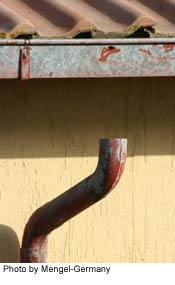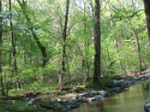Why Stormwater Runoff Determines
Water Quality
Last Updated: June 20, 2024
Is your community experiencing flash floods when it rains hard? That's one reason you might be concerned about stormwater runoff.
Stormwater runoff, also known as urban runoff or simply runoff, happens when that water passes across a hard surface, such as a road or roof, and finds its way into a tributary, creek, lake, or bay, instead of soaking into the soil and replenishing the groundwater. Storm water means rain or melted snow. Professionals write it as all one word.
To talk this language, learn that any hard surface that water runs over instead of penetrating is called an impervious surface. Examples are streets, parking lots, buildings, sidewalks, and industrial facilities. Sometimes you might hear the term impermeable surface, which means the same thing.
Then, what is the significance of this subject? The problem is that stormwater runoff contains not only water but also pollutants ranging from just plain trash to heavy metals.
In the U.S. "point sources" of pollution, where an industry, home, or whatever runs a discharge pipe directly to a stream, have been eliminated except for a few isolated situations.

This puts the spotlight on stormwater runoff, or non-point source pollution, which is preventing us from having clean water running in every stream.
Research and practitioners now focus on what they call BMPs (best management practices) that can reduce the pollutant load and speed at which runoff occurs. These practices bring some delightful new elements into our lives. You might have a rain garden instead of a downspout discharging onto your driveway.
Common pollutants include small amounts of oil and emissions from vehicles, brake dust, road salt, and bacteria from animal waste and litter that find their way onto roads and other hard surfaces.
The real problem is that stormwater runoff usually finds its way rather rapidly into a stream. Engineers thought that was a good thing for the last 100 years or so, and seized every opportunity to promote better drainage. But that trend died when we started becoming more conscious about clean water.
Directing your stormwater into pipes or impervious channels as quickly as possible results in the following four problems.
1. Speed of stormwater runoff ("velocity" to the engineers) is related to the amount of erosion that is caused along the water's pathway.
2. Velocity also can lead to flash flooding and aggravate your attempts at flood prevention. While we want to reserve most discussion of the flooding issue to the dedicated page on that topic, linked just above, we do need to note that volume of rain and melting snow released in a short period of time is a problem that may need to be addressed in your zoning ordinance. For further discussion, read our answer to a site visitor who asked about volume of runoff water.
3. Stormwater runoff often drains from your roof through a gutter system, flows rapidly down a driveway or through a pipe to an underground storm sewer system, and is piped quickly to a stream or river.
But nature intends for rain to percolate slowly into a vegetated earth, with plants purifying any pollutants that may be present.
4. Stormwater also replenishes the groundwater if it isn't placed into a pipe and drained away as quickly as possible.
Best Management Practices (BMPs) for Urban Runoff
Today society is becoming interested in finding stormwater runoff management practices that will result in cleaner water finding its way into streams. If you aren't a stream lover, just think of BMPs as leading to lower costs for drinking water treatment or less energy used to produce drinking water.
Since this is a community development site, let's concentrate on BMPs applicable at the community level. Communities and regional agencies are well placed to lead in implementing stormwater BMPs. In fact, Clean Water Act implementation timetables now in effect require most municipalities to plan stormwater runoff cleansing strategies.
A community should try to avoid the short-term economies of installing more pipes and hard surfaces, and favor innovative measures that confer social, environmental, and long-term economic benefits.
Compounding the challenge is the fact that issues of stream and river health, or flooding, occur at the watershed level. A watershed is the area drained by a particular tributary, stream, or river.
Watersheds are mapped at varying levels of specificity. In the U.S. watershed mapping is under the custody of the Environmental Protection Agency (EPA), although USGS (United States Geological Survey) handles some aspects of mapping as well.
In most parts of the U.S. there is no overall watershed coordination, so the downstream folks are somewhat at the mercy of actions taken upstream. Plan your watershed if your politics allow.
Preferably stormwater runoff solutions would progress from upstream (the direction of the source or origin of the stream) to downstream (toward where a stream enters a larger body of water), but in real life, we usually aren't organized to be so disciplined.
Local Stormwater Runoff Ordinances
A comprehensive local stormwater runoff ordinance can be a terrific measure to advance water quality and limit local flooding damage. Choices of model ordinances are available through the Center for Watershed Protection, but should be adapted to fit your local water situation.
Since construction activities create ideal conditions for soil erosion, silting in nearby streams, most states and localities require siltation fencing and other preventive measures. Building officials often police the erection and maintenance of the siltation fences as part of ordinary inspections.
Many stormwater runoff BMPs can and should be anticipated during development approval and construction. For instance, you could require vegetated buffers along rivers and streams (called riparian buffers, since riparian means pertaining to water).
If you have to choose just one stream protection measure because you don't think you can pass a comprehensive stormwater runoff ordinance, choose this one. The setback from the stream, if properly vegetated, offers real water quality protection.
You can sell it partially as flood protection, since vegetation does discourage bank erosion and slow flood water velocity if a stream does top its banks. But also sell it partly as an aesthetic amenity for the community.
Sometimes the fight to require riparian buffers gets pretty intense if you're in a strong property rights location.
If no public drainage or stormwater district owns the stream, its banks, and an appropriate buffer, then you must require the buffer to be left vegetated and undeveloped, or face public purchase and development of a buffer.
Obtain the largest riparian buffer you can manage. If you can only get 25 feet passed, that's better than nothing. But a natural stream buffer is in the 50 to 150 foot range, depending on soils.
If you don't have a consultant, go see an undisturbed stream (where banks have not been developed and where farmers or others have not straightened, cleared, or altered the creek bank) in your general part of the country.
If you find a relatively pristine stream in your area, Mother Nature will tell you what should be planted along the others. Also a large volume of reference material is available.
Landscaping requirements, particularly pertaining to parking lots, can be quite helpful in slowing stormwater runoff. Choosing plantings that will not require fertilizer in your particular soil and climate conditions is important.
Some fertilizer runs off during rains, adding to the nutrient load of streams. Aren't nutrients good, you ask. Well, yes, but it's a matter of the right quantity. Excess nutrients cause those yucky algae blooms on ponds.
In the recent past, tree and planting islands were encouraged or required in parking lots, but often planting beds were higher in elevation than the parking lot.
Under low impact development theory, the planting beds actually should be depressed and planted with vegetation that like to be wet. These planting beds then can detain stormwater runoff for a time, allowing some natural percolation. Often such planting beds have an overflow outlet for major storms. You will hear these described as bio-retention areas or bioswales.
One of the drawbacks of bioswales is that sometimes they just attract trash and the vegetation becomes overgrown. See the discussion of a website visitor's question about ugly bioswales.
Ordinance provisions relating to the already built environment often refer to "post construction stormwater runoff." In addition to landscaping, they may cover pet waste and unauthorized dumping of materials into the stormwater system.
A common citizen action that community groups can undertake is to stencil warnings against dumping paint, gasoline, or almost anything into nearby stormwater inlets.
Of course that practice would be no more damaging than dumping the same material on bare ground or flushing it down the toilet, but each year such thoughtless acts cost municipalities millions of dollars in water purification costs. Fish habitat and overall water quality in the receiving stream also are diminished by careless dumping.
Retrofit for Success
A few stormwater runoff BMPs can be implemented in fully built-out locations without too much disturbance. When commercial buildings are redeveloped, green roofs can be installed. Building insulation and a pretty new garden spot are side benefits of plantings on top of roofs.
Downspout disconnection programs can redirect water from residential roofs to specially designed vegetated areas known as rain gardens. A number of very attractive plants enjoy wading in the water. The old stormwater system can be partly or completely disconnected. Stormwater from streets, roads, and even driveways can be redirected into a bioretention swale. Bioretention simply means that plants detain water by slowing it down and absorbing some of it, and swale simply means a mound of earth shaped to provide some landscape benefit.
New York City has offered its residents a Greenstreets Program for several years. Residents may request trees, shrubs, and ground cover plantings on vacant traffic islands or medians that now are paved. Although originally conceived as a beautification program, Greenstreets also provides tangible stormwater runoff control benefits.
In addition, there are so-called structural solutions that trap pollutants in a filter. For example, a promising relatively low cost solution is called a Smart Sponge(R), a filter that fits inside a catch basin where there is an inlet that allows water to enter a piped system.
The catch basin idea itself is a way to capture larger-size trash before it goes into the stormwater system. Such filters deserve much more consideration where ideal vegetation-based solutions are improbable.
The Development Review Goal: Require On-Site Detention
At a minimum, in new developments larger than a few scattered infill lots, the local government should require some detention. Often this is accomplished through subdivision regulation, but any type of site plan review or planned development review also should require onsite handling of stormwater. Some states now require this, and courts often are quite sympathetic with property owners who are negatively impacted by drainage from other properties.
Detention is detaining the water for awhile before it enters a stream. The purpose of detention is to allow some settling of solids in the water (sedimentation) and to entrap pollutants in that sedimentation rather than in the ultimate stormwater runoff.
Most laypeople find retention similar. But consider that retention means retaining water on a permanent or near-permanent basis, until it has either been absorbed into the ground or evaporated.
As you might imagine, periodic maintenance is extremely important with either detention or retention. People are likely to complain about either, actually, so require a careful plan to keep these facilities well groomed, well-functioning, and even beautiful. You don't want your retention pond to become the neighborhood's best mosquito breeding ground.
The Planning Goal: Reducing Impervious Surface
In the medium term, to improve your streams and water quality, you need to plot how you can actually reduce your current level of stormwater runoff. This isn't easy in many cities. Paving meant progress to many older adults, and they won't give up that notion easily.
If your municipality is a leader among green communities, perhaps you can require that instead of being re-paved, parking lots or portions of them be retrofitted with permeable surface.
Permeable means that water can penetrate. Decorative permeable paver stones, permeable asphalt (also called porous pavement), and permeable concrete are available, although some methods remain experimental. The pavers probably are the most tested. The permeable surfaces require some maintenance, basically a good vacuuming once or twice a year.
At least for new construction, you could give incentives and bonuses to developers who specify permeable surfaces.
While you're investigating this, make sure that your minimum parking requirements aren't excessive. In fact, maximum parking requirements sometimes are enacted into the zoning ordinance now to prevent over-building of parking.
You could drop parking requirements per se and ask each commercial applicant to calculate his or her own parking requirement and explain the rationale. Chances are, they'll build less parking than your old requirement. In some soil conditions, overflow parking on grass is feasible.
From the stormwater runoff perspective only, parking garages are a better choice than parking lots.
Remember to encourage shared parking arrangements, with the local government being allowed to monitor their nature. This means that a church and a school could share the same parking lot, and be able to accommodate all needs with only a slight increase over what one use would require by itself.
This is one of several times we recommend road diets or skinny streets. If you have four or five lanes of traffic now, consider a decrease to three lanes for less traveled streets. Rip out any street capacity you don't really need and recycle that pavement, or at least consider a complete streets philosophy, where you accommodate pedestrians and bicycles safely. Especially in many central cities, very wide streets remain to accommodate very little traffic.
Then look at your minimum street width requirement. Studies show that people drive slower and are generally more cautious when lane and street widths are less. The fire department will scream about their turning radius, but look at various ways their needs could be accommodated. People will say they must have on-street parking, but is that really true?
Must all residential driveways be paved, or does the strip of grass (or pretty gravel) down the middle work in your climate? Can you give builders meaningful incentive bonuses for permeable patios? How about for rain barrels, cisterns, and rain gardens instead of immediate stormwater runoff?
What if you forgot about curb and gutter requirements, and lined your streets with grassy swales? And rain gardens? See the Kansas City 10,000 Rain Gardens site. They work where there is some soil permeability and where you can provide sufficient separation from groundwater.
Even more effective, retain, create, or purchase as much public open space as financially and physically feasible, in balance with other planning goals. Convert some of the turf grass, requiring fertilizer and gasoline-powered lawn mowing, in your parks to more native vegetation.
Be careful in your overall community design to allow, encourage, and facilitate mixed use development, which should decrease short trips within the neighborhood and thereby make smaller streets possible. Encourage cluster housing on part of the site, with the remainder left in open space.
All of these measures decrease stormwater runoff.
Keeping the Stream Channel Natural
It's interesting that often community leaders nod all the way through my presentation of these ideas. Then they immediately begin to talk about how they should concrete the sides of Sylvan Creek because they're eroding away.
No, the point is that as tempting as it may be, you need to avoid those easy fixes. That's not fair to the people downstream from you, because then you would be pouring your water on them at a faster, more certain rate.
The concrete also doesn't contribute to an aesthetic streambank experience, provide wildlife and fish habitat or shade, or maintain itself in perpetuity without replacement. Chunks of broken concrete in a stream in 40 or 50 years isn't an attractive prospect.
We find them all the time in my area, as in most older cities.
Another thing you can do is to promote the idea that wetlands exist for the purpose of cleansing surface water. If you eliminate wetlands, or compromise them very seriously, as is allowed in some regions, you reduce the land's capacity to handle volume of both stormwater and pollutants.
So watch out that while you're planning your stormwater BMPs with your right hand, your left hand isn't busy signing off on a new concrete channel "stormwater improvement," straightening a stream, or increasing a pipe size without thinking through the alternatives.
Habits That Add Up to Clean Water
Challenge your citizens to learn about the negative effects of their careless disposal of paints, cleaning fluids, insecticides, fertilizers, and so forth.
Train them that if the bottle says toxic, flammable, or corrosive, or if it gives directions on what to do if you toddler swallows some, that product doesn't belong in the stormwater system.
This means that your community must make hazardous waste disposal available in a convenient, frequent format. My community does neither. But most people won't wait 6 or 8 months to dispose of paint, drain cleaner, and gasoline. That storm drain just across the street certainly would be an easy place to pour that stuff someone would like to get rid of.
Street and parking lot cleaning also can prevent pollutants from finding your stream. Encourage or require fast food establishments to eliminate foam or other light-weight floatable cups. Promote recycling of glass and cans.
But couldn't we teach again not to litter? If I never again see a used disposable diaper in the parking lot, it will be a great victory for civility and also for clean water.
To read more about topics related to clean water, see the pages below.
- Making and Keeping a Good Community >
- Community Challenges, Topics & Concepts >
- Sustainability > Stormwater Runoff
Join GOOD COMMUNITY PLUS, which provides you monthly with short features or tips about timely topics for neighborhoods, towns and cities, community organizations, and rural or small town environments. Unsubscribe any time. Give it a try.








